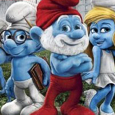Les Armateurs/Sony Pictures Classics et al (August 29 2003), Sony Pictures Home Entertainment (May 4 2004), single disc, 81 mins plus supplements, 1.78:1 anamorphic widescreen, Dolby Digital 5.1 Surround, Rated PG-13, Retail: $24.96
Storyboard:
Unlike any animated feature you’ll have seen before, The Triplets Of Belleville is a wild ride that follows Madame Souza’s pursuit of her kidnapped grandson, Champion. He’s a cyclist who has been abducted and forced to compete in a never-ending race during which the French mafia underworld gamble on who will survive the longest. Crossing the ocean to a wild French/American hybrid metropolis, Souza eventually finds Champion and teams up with the title trio to stage a daring rescue attempt that has the crazed criminals hot on their tracks…
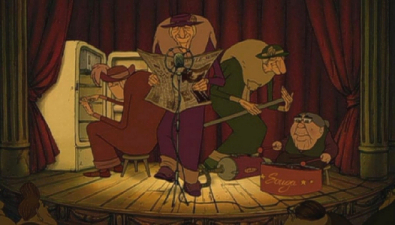
The Sweatbox Review:
To borrow an advertising term which is often misleading and certainly overused: “you’ve never seen anything quite like” The Triplets Of Belleville. Director Sylvain Chomet’s film, released late last year, garnered much critical praise, a number of major awards, and found itself joining Finding Nemo and Brother Bear as one of the three films nominated for the Best Animated Feature Oscar at this year’s Academy Awards. Did it ever really stand a chance against Pixar’s commercial behemoth fish picture? Probably not, but one tends to imagine that Belleville came a pretty close second.
The differences between the two films couldn’t be any more varied. While I’d say nothing to detract from the technical achievement and great entertainment that Nemo provides, it does come from a major studio on a hot roll of churning out the somewhat formulaic goods, while Belleville is an independent film, with an independent voice, financed by no less than over 20 companies. And while Nemo swims safe in his CGI waters, Belleville weaves its own magic and is altogether a different fish: a last gasp of air for the supposedly dying traditionally animated feature film.
For The Triplets Of Belleville is “special”, even more so than the hand-drawn animated films we see each year. Like Tim Burton’s The Nightmare Before Christmas, Belleville draws you into its world – an alternate take on our own – and plays by – and sticks to – its own rules. It’s filled with tiny, intricate details, and when I saw it for the first time in a theater last year, I wanted to go straight back not only just to soak it all up and take in the atmosphere again, but to start to pick out those elaborate idiosyncrasies.
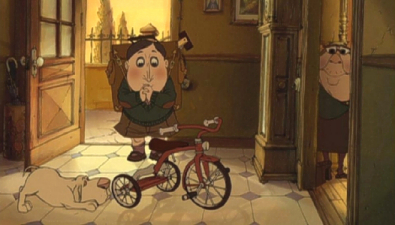
Starting off with an amusing prologue, the opening of the real story of the film begins in Paris, France. Here we find the parentless and sad young boy Champion excited when his club-footed grandmother, Madame Souza, who has taken him in, presents him with a gift of a tricycle. Piano lessons, train sets and a puppy haven’t meant much to him over the years, but the boy takes to his new hobby like a duck to water. Many years – and much relentless training – later, Champion is close to living up to his name, having become a lean, mean cycling machine without an ounce of fat on his body (a radical change from the chubby young boy he once was). Souza believes he’s ready to compete in the annual Tour de France bike race, but while he participates, some shady looking guys snatch him and two other riders away, for their own mysterious reasons.
Hot on the trail is Bruno – Champion’s puppy, now a huge overweight dog – who loves his owner to bits, even if that love is none too reciprocal. Using his amazing sense of smell, Bruno leads Souza across the Atlantic Ocean (I won’t spoil this fantastic sequence here, but it has to be seen and heard to be believed) to Belleville, an anarchic French take on New York, complete with a burger chomping Statue Of Liberty. Once on the streets of Belleville, but no closer to finding her beloved grandson, Madame Souza meets, and finds an affinity with, the now faded Triplets Of Belleville, a once-famous vaudeville act who played on bills with the likes of Josephine Baker and Fred Astaire, among others, back in the day (and shown in that opening prologue).
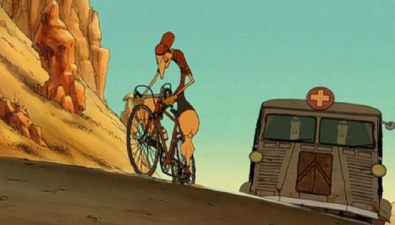
Together, they hook up to resurrect their act, finally finding Champion at the mercy of the French mafia, where he and his co-riders have been set up in some sort of race for life. They’ve been placed on non-moving bikes in front of a movie screen, somewhat like those virtual reality rollercoasters, that shows point-of-view shots of a travelling road. Champion and the riders have been ordered to keep pedalling until they can pedal no more as part of an illegal gambling scheme where those inclined can bet on who survives. Into this dark and seedy underworld go the Triplets, Souza and Bruno, disguising themselves as the crime boss’ henchmen and impersonating the “ride machine” engineer (an affectionate pop at Walt Disney, complete with little rodent-like ears). Causing chaos in the hidden club, the group manage a getaway, but the French mafia are soon on their trail, leading to a blazing and unexpected end.
Taken in one concentrated sitting The Triplets Of Belleville can be a little overwhelming for some. I loved it, taking it in several more times over this past Christmas period, where it played on UK television (under its English title Belleville Rendezvous) thanks to the co-production involvement of the BBC. It’s a bit of an unnerving project, and the surreal characters do nothing to take that feeling away. Madame Souza has a great gut instinct to just keep going, no matter what obstacles get thrown in her way (her final moment of “right, I’ve had enough” when being chased by the mafia’s car is great). She just carries on, be it keeping up with Champion during his training (one wonders if she shouldn’t ride the Tour de France herself!), crossing the ocean, or battling the French mafia – she does it all with the same “ho-hum” determination and expression on her face.
Each of the characters has something about them that is unique. Madame Souza’s expression and clubfoot defines her as much as Champions distinctively French-Jacques Tati nose and disproportionate muscle configuration. There’s also much fun to be had with the mafia boss (always drunk, short and stubby) and his henchmen, all alike, broad-shouldered and appropriately dark and menacing caricatures. Buildings and props all follow the look, with exaggerations in design, which, while totally absurd, still retain a drop of lifelike realism about them. Odd! Topping them all is Bruno, the dog who’s really gone to the dogs, slipping into exquisitely realized dream sequences stemming from his bad experiences with Champion’s model train set when he was a young pup (an endearing running gag).

The opening is sheer class as well, created – since the sequence is set in the early 1930s – in the “rubber hose” animation of the time. Here the scene mostly copycats the Fleischer Brothers’ technique, though this style was predominant in all Hollywood cartoons at this time. Most fun is that fact that the scene (which shows the Triplets in their vaudeville act heyday) is presented – intentionally – close to the 1.33:1 Academy screen ratio of the era, widening as the film really kicks in. This opening is the only section that may not be for the very young eyes: a topless (but nonetheless very caricatured and actually quite harmless) Josephine Baker is glimpsed for a few seconds, and it’s all for comic effect. Accompanied by the main title theme, the sequence certainly sets up the surreal tone to follow, as well as the fact that the film you are about to see is a little…different. Different? Well, yes, but original and inventive too!
Best of all is Chomet’s choice to play the film almost without dialogue throughout, which just helps the characters and their motives seem that much more real, in a sense. It’s probably this style that has drawn comparisons with the similar pantomime works of that other great French comedian Jacques Tati (whom is paid tribute to via a poster of the classic Monsieur Hulot’s Holiday in the Triplets’ home), and there is certainly a similarity to be made, though I found the “moderness” of Belleville’s overall feel to be in line with Jean-Pierre Jeunet’s films such as Delicatessen, The City Of Lost Children and, most recently, Amélie, particularly in the use of rhythmic music.
In fact, music plays a large part in The Triplets Of Belleville, but again for the most part defies description. Certainly it’s the score – from the toe-tapping, Oscar-nominated opening song to Souza’s playing with the Triplets’ performance in the film – that holds everything together. It is, however, also responsible for perhaps the weakest section, the climatic chase, which while amusing and full of amazing touches, doesn’t feel as intense or exciting as it perhaps should. Ben Charest’s score keeps up the momentum throughout, but loses it a little in this final reel, combining the feel of typical Mission: Impossible-type music, but fumbling with whether to keep it styled in the 1950s-ish universe the film plays in, or the now traditional ultra-hip synthesized drum and bass approach. But if that is a criticism of the film, it’s one of the very few I found, since the whole adds up to much more than any one part could affect.

Chomet started life as a fan of the Tin Tin comic books, and was a graphic illustrator himself before creating his first animated film, the 26-minute The Old Lady And The Pigeons (1997), which was finally completed after ten years. Building on the success the short brought him, Chomet was able to pitch Belleville (originally a sequel of sorts), but he was denied use of the old lady from his earlier film, and so Madame Souza was created as a replacement. The film took five years to get off the ground and was animated in sections in various parts of the world, but it never feels fractured because of this process. It’s been designed and animated with the 1960s Xerox process of the Disney animated features in mind, such as The Sword In The Stone, The Jungle Book and 101 Dalmatians (a personal Chomet favorite), with the animators’ sketchy lines very much on show, and providing true life within the characters that can sometimes feel missing from recent fare.
The film was completed digitally, so we get the clean and vibrant look of modern day animated films, but with all the vitality of the original animator’s drawings intact. This process also allowed, naturally, for the inclusion of a great deal of CGI props, such as the bikes and vehicles themselves, backgrounds and some effects animation touches – none of which pulled me out of the film, though they are fairly easy to spot (more because of the quality of the work rather than any inconsistency in blending the two forms). Animation throughout is great, absolutely fluid and even more impressive given how the film was put together. Belleville really is a masterpiece of animation acting and direction, filled with the kind of intricate nuances that reward multiple viewings.
Perhaps the one happy side effect of the American studios closing their hand-drawn facilities is the knock-on effect that this seems to be having in Europe and around the world. Already we have seen that full quality, innovative animated films can be produced outside the Hollywood system, but this new breed of film brings with it a cultural legacy and new approach all of its own. The biggest challenge these films face is distribution: features such as Help! I’m A Fish, Jester Till, and Filmax’s El Cid: The Legend and Nocturna still are without the international sales that they need to make more films like them viable. With The Triplets Of Belleville, Sylvain Chomet has certainly brought a fresh take on animation to the table, and proving that there is so much more life in the old 2D dog yet. Lets hope more like him get the chance to show it too. In the meantime, vivre le animated film!
Is This Thing Loaded?
While not the extensive two-disc set found in its native France, and even shorn of a couple of features from its single disc UK counterpart, this US edition of The Triplets Of Belleville has been given a very decent if not spectacular treatment by Sony Pictures Classics.

The Making Of The Triplets Of Belleville is an almost sixteen minute look at the production process featuring interviews with director Chomet, music score composer Benoit Charest animator Hugues Martel and art director Evgeni Tomov (some in French with subtitles). The documentary featurette takes aspects of the entire production, from the stylistic choices (the city itself is a combination of New York, Paris and Montreal) to the ultimate achievements (such as how to musically play a vacuum cleaner), and is generally refreshing in its old-fashioned way of presenting things as they are rather than glazing over information with standard studio fluff. The doc is a full-frame presentation, expertly transferred, it seems, from a PAL master, so likely this was produced for the UK edition, with behind-the-scenes footage interspersed with clips from the film (strangely in an anamorphic squeeze).

Next up is The Cartoon According To Sylvain Chomet, in which the director explains his approach to drawing and animation. Lasting 5:20 minutes, this plays as an addition to the making of documentary, with Chomet demonstrating the basics of his technique, the Triplets’ character design and inspiration. Another genuinely informative piece, his relaxed attitude actually commands attention and I found myself intrigued by what he had to say.
Chomet and score composer Charest can be heard again on Three Select Scene Commentaries. Culled again from the original French edition (noticeable from the PAL conversion and French background art), these “Séquences Commenteés” are for three scenes in the movie: the Opening, Restaurant Performance and Turning The Wheel. Presented in anamorphic widescreen, the participants speak in their native French, with selectable subtitles in English only. If only they’d given us a full-length feature track! There’s a wealth of info here, from the origins of the musical theme, the rating of the film based on Baker’s appearance, how the use of the Triplets’ choice of instruments came about, and the film’s sound design. Combined, these clips make up almost seven minutes of additional material, but they’re pretty tricky to find: despite the being labelled on the packaging, it took me a while to discover them (they’re located via the “arrow” in the Featurettes section).

Craziest of all is the Belleville Rendezvous Music Video for the Oscar-nominated song (ahh, now we see where it gets its English-language title). Performed by the enigmatic “M”, I was surprised to see an eccentric and very theatrical looking man singing away (I can’t be the only one who thought the voice sounded female?). However, it’s a great video, with M locked up in a looney bin where he’s seen relating all to an analyst. Eventually, the visions in his head get too much for him and he becomes a cartoon himself, integrated into clips from the movie. I love it when animated videos are created especially for animated movie tunes, and this one is so surreal it needs to be seen to be believed. Shame about the quality, though, which looks like a dubbed copy from a PAL transfer – not the greatest, but the catchy song carries it through effortlessly. Presented in letterboxed (non-anamorphic) widescreen, the clip lasts 3:25 minutes, with an additional 50-second ad for the CD soundtrack, which due to the infectious spirit of the track, somehow doesn’t seem gratuitous at all.
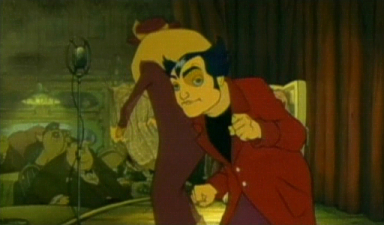
Belleville Rendezvous (the song) also peps up the zippy Theatrical Trailer. The case notes trailers plural but I could only find this one, though it is accessible twice, either from the main menu or among the Special Features, presented in an anamorphic widescreen print almost as good as the film itself. Launching off the back of several critical praise quotes and award pick-ups, the trailer is a barrage of music and visuals, pushing the wide scope of the film to the fore (also check out some of the signage for a look at the original French backgrounds). It’s one of the simplest but most effective previews for ages, which exposes all the great moments, but gives absolutely nothing away about the film.
The menus, while not animated, do feature lots of tiny detail, much of which begs for additional “Easter Egg” hunts, though I couldn’t find any further links. One handy feature is the “play all” option that will play all the featurettes (the making doc, Chomet’s solo chat and the commentary scenes) as one. If all of this is not enough for you, the word is that a possible multi-disc Canadian edition will present the original French version of the film, with additional extras, but this is fine to be getting along with, and will more than satisfy most fans of the film and those coming to it for the first time.
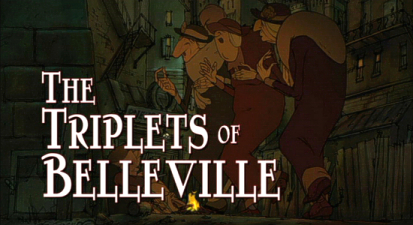
Case Study:
Sony have presented Triplets on disc with its original theatrical poster art on the front cover and an adaptation of the original French poster on the reverse. Inside, we get a nice disc art rendering of Champion in shadow, while an insert merely pushes other related Sony titles such as Tokyo Godfathers and Metropolis. In France, a deluxe 2-disc edition adds a lovely slipcover and several alternative extras, though there is no provision for English audiences.
Ink And Paint:
Instead of all the deep blues, bright reds and vibrant purples that we normally associate with animated films (I love those Disney night sky blues), Sylvain Chomet here has chosen a much more muted color palette – all of which is rendered perfectly with this absolutely pristine print. Orange is a much-used color throughout, and this transfer is balanced correctly and gives the film great warmth, even in the more sparsely colored sequences. The print used is actually the English language version, named Belleville Rendezvous, and the one annoying blip against it is the forced subtitled caption that appears alongside the main title that labels it as The Triplets Of Belleville. Why create two titles for international release?
Presented in 1.78:1 anamorphic widescreen, the superimposed title is nothing but a minor bugbear, and no matter, since the rest of the movie looks so good. Be aware that the disc opens with a “this film has been modified to fit this screen” warning. I’ve no idea what this is about, nor why it was included, my only feeling being that, for intentional effect, the film opens in Academy ratio (actually printed within the wider frame) and opens out to the broader image – maybe the guys in the Sony DVD lab were thrown off by this switch in ratios? However, there’s nothing to worry about: the film is just as it was in the theater, on the international DVD and UK television screenings, and what looks to be a fine digital-to-digital transfer here is indeed 1.78:1 anamorphic.
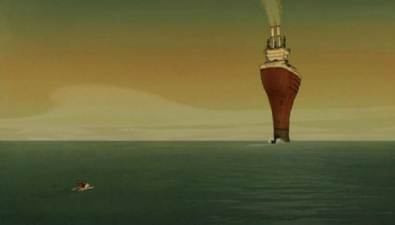
Scratch Tracks:
Presented only in English Dolby Digital, the film’s soundtrack matches the visuals in their low-key approach. One might initially think that it is odd for a Sony disc not to include the original French language track, but The Triplets Of Belleville was in fact created wholly in the two languages, with English text artwork stepping in for the main titles, signs, billboards, etc, so there really are two different versions of the film. It’s just a shame, given the short running time, that both were not included here, but, as they say, c’est la vie.
As it is, there are only a few lines of dialogue, never used to really push the story on, and mainly restricted to ambient sound and spot effects. The film’s handful of spoken lines (a couple at the top and a couple at the end) are spoken in English, as it was in the UK and original US theatrical versions. Sound overall never feels “empty”, but is not filled with the gung-ho approach of the big Hollywood blockbusters either. But that’s not to say that Belleville isn’t an enjoyable aural experience, with some wonderfully observed ambience. There really are some rich sounds to be found in here – especially the music – all of which sounds just as it should. A Spanish (why no French?) language dub is also included, for those few lines!
Final Cut:
The overall melancholy feel of The Triplets Of Belleville is one of its major strengths, and it is certainly a film that should be seen this year by anyone remotely interested in animation as an art form and those who wish to see the boundaries of accepted cartooning pushed, both visually and in storytelling. It may not be for everyone (a couple of my friends found it “creepy”), but there’s no denying that Belleville is one of the most original animated films in years. Hopefully it will eventually find its rightful place in animated history, being regarded either as the first of a new breed (the current wave of personal independent films) as Toy Story was, or as a magical one-off, never to be repeated, like The Nightmare Before Christmas.
Now that Chomet has gotten his most personal whims out of the way (his tributes to Tati/Hulot, the Fleischers, etc), I hope to see an even deeper layered and more textured film from him on his next outing. Certainly I wish Chomet well with his next project (I can’t wait to see what his imagination comes up with to top this), and thank him in the meantime for the year’s true “best animated feature”.
 | ||
 |








